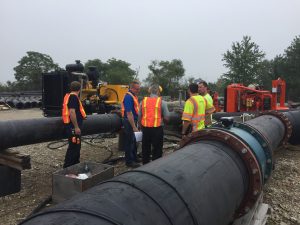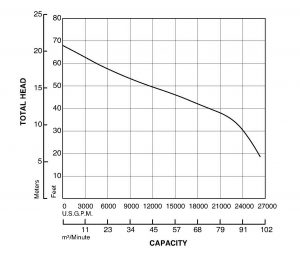News
Sometimes in the quest to have blogs that are exciting, unique or educational we overlook the most basic procedures we go through in the daily course of business. So although it might not be the most exhilarating topic in the world, let’s cover the subject of placing an order with Hydra-Tech Pumps. We take purchase orders from our customers any way they prefer, via email, verbally by phone, and by fax.
Orders By Email: htpump@hydra-tech.com This is the best and easiest way to get an order in our hands, especially if a purchase order is being generated.
Orders By Phone: (570) 645-3779 Anyone who answers the phone at Hydra-Tech can take your order – we’re looking for Item Part Number or Description, quantity, Purchase Order number (if used), and we want to know if you would like an order confirmation sent or not.
Orders By Fax: (570) 645-4061 We still get some orders via fax – this is another good way to get your order in our hands if a purchase order is being generated. Let us know if you would like an order confirmation sent or not.
We are always willing to send an order confirmation with pricing and an estimated ship date – just let us know when you place your order. Keep in mind that estimated ship dates are based on lead times provided at the time of a quote (if one was supplied) and that lead time could have changed depending on the age of the quote.
If your company has specific shipping / freight instructions and carrier preferences please make sure that we are aware of those requirements. We ship smaller orders with UPS and use a variety of carriers for LTL shipments.
Finally we appreciate our customers big and small. Thanks for your continued confidence in our products, our people, and our company. Please let us know about the next challenge Hydra-Tech Pumps can help you to overcome!
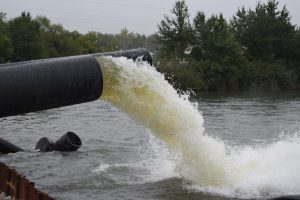
With that 400 horsepower John Deere engine humming and 140 gallons per minute at 4000 PSI of hydraulic fluid spinning the vane motor and mixed flow impeller at the heart of the S30M, the water was moving and delivered almost exactly the kind of output we expected. We worked our way up and down the hydraulics input profiles at several head pressure points. Based on the readings, we developed the max curve seen here. Also on site was an independent Professional Engineer who is in the process of certifying our curves for the S30M. Squeezing every ounce of horsepower out of the engine we were moving more than 25,000 gallons per minute of water at nearly 30 feet of head. When pushed to the max, we almost reached 70 feet of head. Check out our curve below.
So where do you put a big boy like this to work for you? Low to medium head applications like flood control, levee work, dam construction are just a few of the potential applications. Our Axial Flow pump line now offers our customers a 6″, 8″, 12″, 18″, 24″ and 30″ pump depending on your needs. Can one of Hydra-Tech’s axial flow pumps move some water for your company?
As “we” (Hydra-Tech Pumps and our customers) make the transition to Final Tier Four engines through the end of 2018 we wanted to put some important information in front of you. There are two key things that you need to know as you begin to operate and maintain hydraulic power units with Final Tier Four engines as their power plant.
Ultra-Low Sulphur Diesel (ULSD)
Final Tier Four (for that matter Interim Tier Four as well) diesel engines require Ultra Low Sulphur Diesel – to be clear the fuel must contain less than 15 parts per million of Sulphur. Anything above this level will impact the performance of the engine and its ability to operate.
Generally speaking, ULSD has been available in the United States and Canada since it was widely introduced in 2006. So for our domestic customers and those in Canada, there is not much concern about running non-ULSD through a Final Tier Four engine. There is a map that updates on a monthly basis the diesel fuel Sulphur levels in every country around the world – this is a nice resource for our international customers who might want to see what the diesel fuel Sulphur content levels are in their country. Check out https://www.unenvironment.org/explore-topics/transport/what-we-do/partnership-clean-fuels-and-vehicles/sulphur-campaign
Diesel Exhaust Fluid (DEF)
Diesel exhaust fluid is a liquid solution comprised of 32.5% urea and 67.5% deionized water that is used in the exhaust after treatment system on Final Tier Four industrial engines of 75 horsepower or higher. Basically it is injected into the exhaust pipeline to eliminate nitrogen oxides which are harmful pollutants. The requirement on us as a manufacturer of hydraulic power units is that the DEF tank contain an appropriate volume as a ratio to the fuel capacity. If our HPU has a 100 gallon diesel fuel cell then the DEF tank will need to hold 3-4% of that volume, or 3-4 gallons of DEF – there is some variation of the ratio from one engine manufacturer to another.
As you begin to build Final Tier Four engine based hydraulic power units (and other equipment) into your fleet, make sure that you are filling the fuel cells with Ultra-Low Sulphur Diesel and topping off the DEF tanks!
On January 31st, 1963 in the Krasnoye Sormovo shipyard in Gorky, Russia the keel of a Juliett class cruise missile submarine K-77 (also referred to as the Juliett 484) was laid down. Two years later on March 11th she was launched and in the fall of 1965, commissioned into the Russian Navy’s Northern Fleet. The submarine was 282 feet long and equipped with 4 nuclear missiles capable of striking targets as far away as 300 miles as well as 22 torpedoes. For 30 years, this submarine patrolled North Atlantic Ocean, the Mediterranean Sea, and later in its career the coast of West Africa as well as the Caribbean Sea near the US Virgin Islands – often her time was spent following US Navy aircraft carrier battle groups and other submarines as well. After the end of the cold war, sometime post 1991 the K-77 was decommissioned. By 1994 all of the Juliett class submarines had been retired from the Russian naval fleet.
In the spring of 1993, a Finnish businessman convinced the Russian government to sell him two Juliett class submarines, one of which was the K-77. The K-77 was moved to Helsinki where it became a bar / restaurant and was one year the location for a beauty pageant where a “Miss Submarine” was crowned – (the winner later became the Finnish businessman’s 3rd wife). The bar and restaurant wasn’t a very lucrative endeavour and at some point the sub was leased to a Canadian promoter who wanted to create a tourist attraction and the sub was towed across the Atlantic to Tampa, Florida. This effort never amounted to much and there were a couple of attempts to sell the submarine on eBay.
Eventually the submarine caught the eye of Intermedia Film Equities Ltd., who chartered the sub for $200,000 and had her towed to Halifax, Nova Scotia to be used in the filming of the movie K-19: The Widowmaker starring Harrison Ford and Liam Neeson. The K-77 was modified to resemble the correct K-19 sub for filming.
 After filming wrapped in 2002, the submarine was purchased by the USS Saratoga Museum foundation and was towed to Collier Point Park in Providence, Rhode Island. The hope was that the K-77 / Juliett 484 submarine and the USS Saratoga CV-60, a Forrestal-class supercarrier built in the 1950s that served the United States Navy from Vietnam through Operation Desert Storm, would someday be displayed together. During each vessel’s service to their respective nations, they spent plenty of time in the waters with one another. In fact there is a story about the President of the Saratoga Museum Foundation doing some research on the Juliett 484. He was in a bar drinking with former Juliett 484 naval officers when one of them produced a photograph of the USS Saratoga taken through the periscope of the sub further confirming that the two had spent time in the waters together during the cold war playing cat and mouse.
After filming wrapped in 2002, the submarine was purchased by the USS Saratoga Museum foundation and was towed to Collier Point Park in Providence, Rhode Island. The hope was that the K-77 / Juliett 484 submarine and the USS Saratoga CV-60, a Forrestal-class supercarrier built in the 1950s that served the United States Navy from Vietnam through Operation Desert Storm, would someday be displayed together. During each vessel’s service to their respective nations, they spent plenty of time in the waters with one another. In fact there is a story about the President of the Saratoga Museum Foundation doing some research on the Juliett 484. He was in a bar drinking with former Juliett 484 naval officers when one of them produced a photograph of the USS Saratoga taken through the periscope of the sub further confirming that the two had spent time in the waters together during the cold war playing cat and mouse.
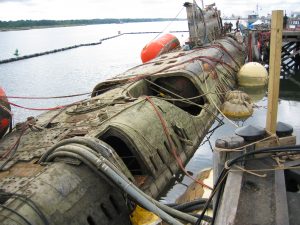 The sub was actively used as a tourist attraction between August of 2002 and March of 2007 and hosted some 40,000 visitors to its deck and cramped interior. Interesting fact – sailors who served on the K-77 / Juliett 484 were required to be no taller than 5’8”. Then on April 18, 2007 tragedy struck. During a particularly vicious storm the sub took on enough water through some off its hatches to sink to the bottom of the waterfront mooring in the Providence River. In the more than 12 months it spend resting in the silt on the bottom of the river, it was determined that it was damaged beyond what could reasonably be repaired.
The sub was actively used as a tourist attraction between August of 2002 and March of 2007 and hosted some 40,000 visitors to its deck and cramped interior. Interesting fact – sailors who served on the K-77 / Juliett 484 were required to be no taller than 5’8”. Then on April 18, 2007 tragedy struck. During a particularly vicious storm the sub took on enough water through some off its hatches to sink to the bottom of the waterfront mooring in the Providence River. In the more than 12 months it spend resting in the silt on the bottom of the river, it was determined that it was damaged beyond what could reasonably be repaired.
Unfortunately the sinking brought about the eventual demise of the K-77 / Juliett 484, but it also brings us to the part where we had a hand in her story. On June 2, 2008 divers from Mobile Diving and Salvage Unit Two in Norfolk Virginia (Navy) arrived and began preparations to raise the submarine. They were joined by members of the US Army Dive Company based out of Fort Eustis, VA and in a unique joint effort, real world training opportunity, almost 100 active and reserve Sailors and Soldiers set about raising the sub off of the riverbed.
First the team sealed the hatches that had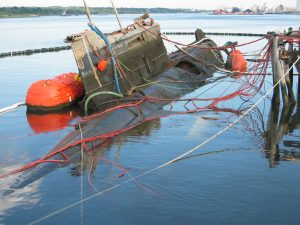 allowed water in and led to the sinking in the first place, used 8 hydraulically driven submersible dewatering pumps (some Hydra-Tech Pump models included) to remove the water from the inside of the sub while the submarine was raised via lift bands run under the sub and attached to pontoons.
allowed water in and led to the sinking in the first place, used 8 hydraulically driven submersible dewatering pumps (some Hydra-Tech Pump models included) to remove the water from the inside of the sub while the submarine was raised via lift bands run under the sub and attached to pontoons.
Once raised the assessment of the interior of the sub confirmed what was feared, that the time spent on the bottom of the river had damaged everything beyond what was economically feasible to repair / restore. Items like the periscope, torpedo tube doors, missile firing stations, engine order telegraphs and other instrumentation and controls would be removed and saved, but eventually the sub was sold to a scrap yard 1000 feet up river and was towed to its final resting placed were the 3500 ton behemoth would be cut apart for scrap metal.
This is going to sound like a repeat of a recent story but it is not – dredging just seems to be an application that Hydra-Tech Pumps are being called on to do more and more lately. This story is out of New Zealand – our friend Doug Kirby, who is two years new to Hydra-Tech Pumps as a representative and distributor of our products, is involved in exactly the kind of dirty jobs you would expect with a name like Slurry Services. 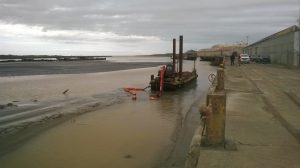
In preparing for a significant dredging project on the west coast of the north island of New Zealand, Doug ordered a 6” Sand / Slurry Pump (S6CSL) from Hydra-Tech Pumps as the key component in their approach to the job. The project they were preparing for involved removing river sediment from a marina to create a channel to allow better access to the ocean for the Coast Guard rescue boat and recreational boats as well. They had been launching off of the beach and this work would prevent this and make the boaters’ lives a little easier.
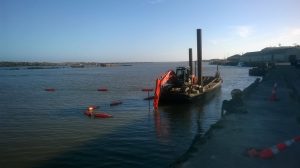 Doug and his team put together their barge / excavator / pump set up (for anyone who has ever watched Discovery Channel’s Bearing Sea Gold this concept is familiar) and got to work. The biggest challenge was ripping up the bed – a mixture of compacted fine clay and sediment as well as larger solids and debris. They worked to tear up the bed and move the mixture to the pump and operated only when the tide was going out so that the sediment wasn’t coming back to where they were working. The water and solids (less the tree branches and other larger debris) was pumped over 1000 feet away.
Doug and his team put together their barge / excavator / pump set up (for anyone who has ever watched Discovery Channel’s Bearing Sea Gold this concept is familiar) and got to work. The biggest challenge was ripping up the bed – a mixture of compacted fine clay and sediment as well as larger solids and debris. They worked to tear up the bed and move the mixture to the pump and operated only when the tide was going out so that the sediment wasn’t coming back to where they were working. The water and solids (less the tree branches and other larger debris) was pumped over 1000 feet away.
Despite the very difficult dredging conditions they averaged 32 cubic yards (86 tons) of solids per hour from day 1. The project was a success and has led to additional opportunities based on their short set up time and efficiency in getting the job done. The next job is on the east coast of the island where the sediment is primarily sand and flows more easily, here over a similar pumping distance they expect to move in excess of 60 cubic yards (162 tons) of material an hour.
Applications like many other things seem to come in waves. Right now it appears as though Doug and many of our other marine / diving customers are putting Hydra-Tech Pumps to work to earn dredging jobs and exceed expectations!
This is going to sound like a repeat of a recent story but it is not – dredging just seems to be an application that Hydra-Tech Pumps are being called on to do more and more lately. This story is out of New Zealand – our friend Doug Kirby, who is two years new to Hydra-Tech Pumps as a representative and distributor of our products, is involved in exactly the kind of dirty jobs you would expect with a name like Slurry Services. 
In preparing for a significant dredging project on the west coast of the north island of New Zealand, Doug ordered a 6” Sand / Slurry Pump (S6CSL) from Hydra-Tech Pumps as the key component in their approach to the job. The project they were preparing for involved removing river sediment from a marina to create a channel to allow better access to the ocean for the Coast Guard rescue boat and recreational boats as well. They had been launching off of the beach and this work would prevent this and make the boaters’ lives a little easier.
 Doug and his team put together their barge / excavator / pump set up (for anyone who has ever watched Discovery Channel’s Bearing Sea Gold this concept is familiar) and got to work. The biggest challenge was ripping up the bed – a mixture of compacted fine clay and sediment as well as larger solids and debris. They worked to tear up the bed and move the mixture to the pump and operated only when the tide was going out so that the sediment wasn’t coming back to where they were working. The water and solids (less the tree branches and other larger debris) was pumped over 1000 feet away.
Doug and his team put together their barge / excavator / pump set up (for anyone who has ever watched Discovery Channel’s Bearing Sea Gold this concept is familiar) and got to work. The biggest challenge was ripping up the bed – a mixture of compacted fine clay and sediment as well as larger solids and debris. They worked to tear up the bed and move the mixture to the pump and operated only when the tide was going out so that the sediment wasn’t coming back to where they were working. The water and solids (less the tree branches and other larger debris) was pumped over 1000 feet away.
Despite the very difficult dredging conditions they averaged 32 cubic yards (86 tons) of solids per hour from day 1. The project was a success and has led to additional opportunities based on their short set up time and efficiency in getting the job done. The next job is on the east coast of the island where the sediment is primarily sand and flows more easily, here over a similar pumping distance they expect to move in excess of 60 cubic yards (162 tons) of material an hour.
Applications like many other things seem to come in waves. Right now it appears as though Doug and many of our other marine / diving customers are putting Hydra-Tech Pumps to work to earn dredging jobs and exceed expectations!
Don Coleman of Blue Diving & Salvage LLC in Mobile, Alabama had quoted a big opportunity and wanted to change how he was going to approach the job. Don’s company provides inland / onshore commercial diving services along the Gulf Coast and had recently submitted a proposal to a condominium association for some dredging work along the inlet to their private marina. The requirement? Remove an average of 30” of coarse sand from an area 220’ x 20’ at a depth of up to 5 feet so that boats aren’t scraping bottom on their way in and out of the marina. Deliver the sand 90’ away and build an area of beach back up where some erosion has occurred.
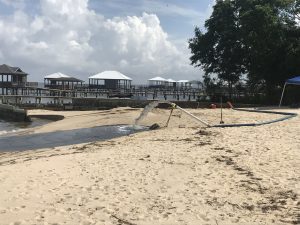
In the lead up to hearing from the association that he had won the business, Don contacted Hydra-Tech Pumps to help him to determine what different options we could provide to make this job go smoothly. He was familiar with Hydra-Tech Pumps because he has occasionally rented for other jobs through some of the rental companies. After a number of phone calls and emails, Don had information on virtually every kind of 4” pump we manufacture – this was something that he thanked us for later. He said that it meant a lot that we took the time to go through the options and explain the technical differences in features, construction, applications and price on all of the different pumps without rushing him or abandoning him in the learning process. Don placed an order for a ductile iron 4” pump at almost the same time that he heard that he had been awarded the job at the condo association. Hydra-Tech built the pump in three days and shipped it to Blue Diving and Salvage on the fourth.
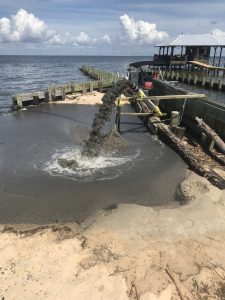
Within a week they were on site and ready to go. The Hydra-Tech pump was suspended off of the front of the boat – the strainer was swapped out for a flange and fitting to get them to a length of suction hose and a nozzle that the diver would hold. In two and a half days and about 22 hours of run time, the diver and the pump moved over 400 cubic yards of sand or a little over 18 yards an hour. The job was done and Don was happy with his pump and experience. The best surprise was still to come – when he removed the top from the volute to inspect the impeller for wear, it was minimal considering what the pump had been doing for 22 hours.
We hope that Don will be a Hydra-Tech Pumps customer for a long time. If you want to check out his website go to www.bluediverllc.com. How can Hydra-Tech Pumps help your company to get the job done?
Is your hydraulic power unit not working correctly, or how you believe it should be working? Here are a few steps to make an initial diagnosis of what may be causing a low or no pressure situation with a Hydra-Tech hydraulic power unit system.
1) Make sure the hydraulic hoses are not connected.
2) Start the unit with the oil cold
3) Activate the hydraulics by engaging the HYDRAULIC CONTROL VALVE (H.C Valve) by turning it clockwise until it stops
4) Read the high pressure gauge.
5) If the pressure does not build to at least 2200psi (HT25DD and above or 1100psi for HT20G and below), then…
6) Stop the engine, remove the reservoir cover and locate the relief valve
7) Look to find the discharge pipe that comes off the relief valve body and dumps into the tank.
8) Start the unit (with the oil cold) and engage the HYDRAULIC CONTROL VALVE (H.C Valve) by turning it clockwise until it stops.
9) Reach into the tank and feel if any oil is coming out of the discharge pipe off the relief valve.
10) If oil flow IS coming out, the relief valve cartridge may have some debris in it and will need to be removed and cleaned. Or, the steel tubing going from the relief valve to the H.C. Valve may be cracked or loose and needs repair. Or, the aluminum block housing the relief valve cartridge may be cracked.
11) Check and or correct all of these conditions and return to steps 2-9, then…
12) If the proper pressure is not being attained, and/or if no if no oil is flowing from the discharge pipe the hydraulic pump is probably worn out.
NOTE: Noises in the hydraulic system are usually from cavitation due to a bad hydraulic pump. This is usually caused by dirt or contamination getting into the system. When contamination and cavitation occurs, the pump will get hot and the pressure will usually go up and down with the engine speed. If the hydraulic pump is replaced, the reservoir will have to be drained and thoroughly cleaned, the suction strainer will need to be cleaned, the system will need to be purged of any contaminated hydraulic oil, the return filter must be replaced and the case on the hydraulic pump filled with oil BEFORE re-starting the engine.
If your power unit is still not working correctly after this, please contact us for additional help!
Problem:
There are some applications where using a centrifugal pump is best suited for the job but the suction lift limitations of centrifugal pumps create a problem.
A typical centrifugal pump without vacuum assist priming can reasonably lift water only 15-20 feet before running into cavitation issues and loss of performance. Adding a vacuum assist primer to remove air and lower the atmospheric pressure in the suction line can increase the effective suction lift to an absolute maximum of 34 feet (at sea level).
At these high suction lifts there is still a significant loss of pump performance.
What do you do if the suction lift exceeds these limits?
The Hydra-Tech Solution:
Adding a Hydra-Tech hydraulic submersible pump to lift the water to the centrifugal pump will solve the high suction lift problem.
By lifting the water to the centrifugal pump you also remove the performance loss issues caused by high suction lifts.
Click on this link to see an image of how this works: High Lift S6300
In this application the customer has an offshore fire-fighting platform that is elevated 90 feet (27 Meters) above the sea level. The high-pressure centrifugal pump is the best pump for fire fighting. The light suction lift does not allow the centrifugal pump to pull water from the sea.
By adding the Hydra-Tech S6300 12” pump to the suction line they were able to overcome the high suction lift problem.
Hydra-Tech Pumps provided a Hydraulic Kit that uses the existing engine power to drive the S6300 Pump. This was a win-win for the customer and proves the concept of overcoming high suction lift problems.
Problem:
There are some applications where using a centrifugal pump is best suited for the job but the suction lift limitations of centrifugal pumps create a problem.
A typical centrifugal pump without vacuum assist priming can reasonably lift water only 15-20 feet before running into cavitation issues and loss of performance. Adding a vacuum assist primer to remove air and lower the atmospheric pressure in the suction line can increase the effective suction lift to an absolute maximum of 34 feet (at sea level).
At these high suction lifts there is still a significant loss of pump performance.
What do you do if the suction lift exceeds these limits?
The Hydra-Tech Solution:
Adding a Hydra-Tech hydraulic submersible pump to lift the water to the centrifugal pump will solve the high suction lift problem.
By lifting the water to the centrifugal pump you also remove the performance loss issues caused by high suction lifts.
Click on this link to see an image of how this works: High Lift S6300
In this application the customer has an offshore fire-fighting platform that is elevated 90 feet (27 Meters) above the sea level. The high-pressure centrifugal pump is the best pump for fire fighting. The light suction lift does not allow the centrifugal pump to pull water from the sea.
By adding the Hydra-Tech S6300 12” pump to the suction line they were able to overcome the high suction lift problem.
Hydra-Tech Pumps provided a Hydraulic Kit that uses the existing engine power to drive the S6300 Pump. This was a win-win for the customer and proves the concept of overcoming high suction lift problems.

